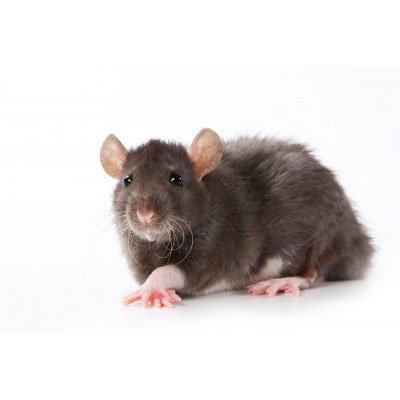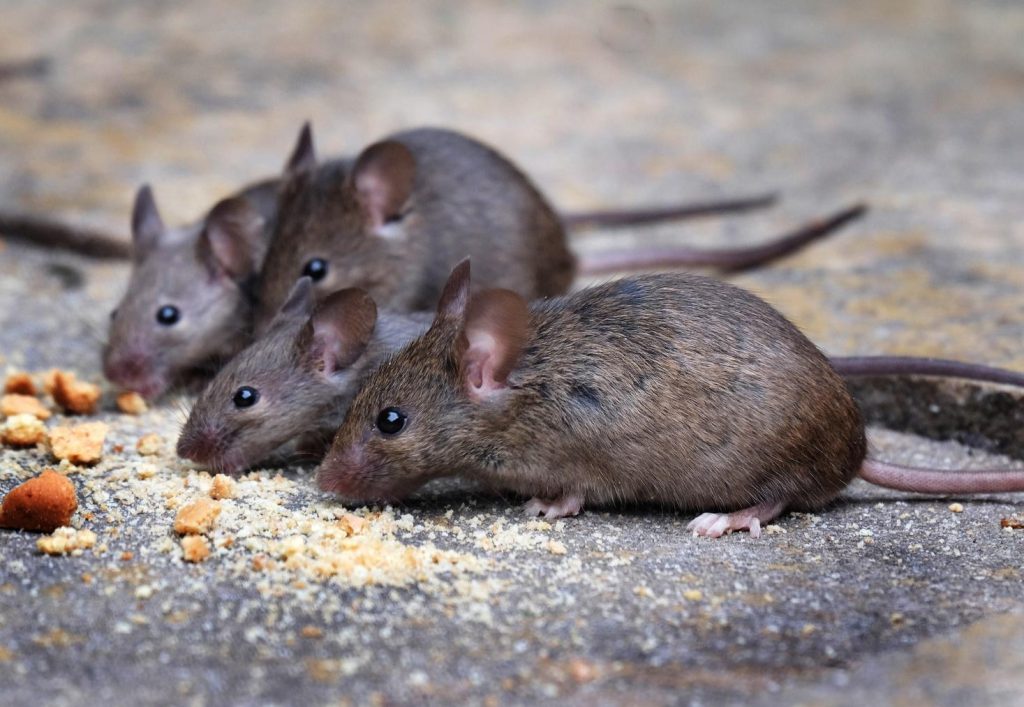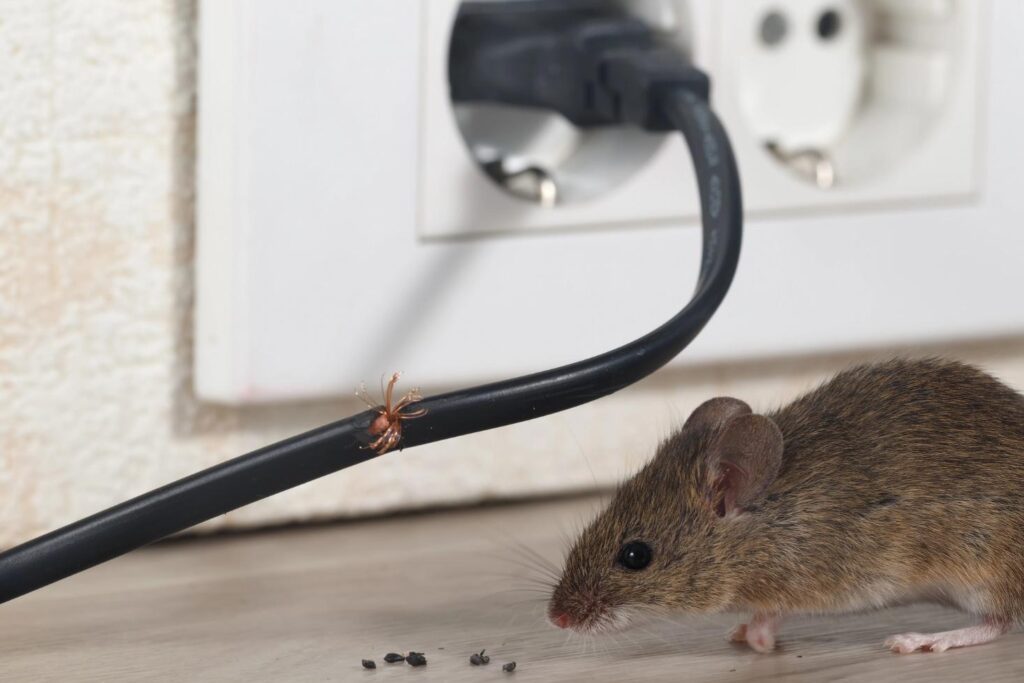
NORWAY RAT
Also called the brown rat, house rat, barn rat, sewer rat, gray rat, or wharf rat, it is a slightly larger animal than the roof rat. The nose is blunt, the ears are small and close set. The tail is scaly, semi-naked and shorter than the head and body combined. Adult Norway rats weigh an average of about 1 pound. Their fur is coarse and usually is brownish or reddish-gray above, and whitish-gray on the belly. Black coloured Norway rats can occur in some locations.
Identification
Feeding: Norway rats will eat almost anything, but prefer to have cereal grain, meat, nuts, fish, and fruit.
Hibernation: Norway rats do not hibernate.
Nesting: Nests are usually found in underground burrows or at ground level. Nests may be lined with cloth, paper, or other fibrous material.
Reproduction: Females mature at 3 months of age and may come into heat every 4 or 5 days. Breeding often peaks in spring and fall, on average a female Norway rat has 4 – 6 litters a year, with 6 – 12 young per litter.
Norway Rats can:
Pass through any opening larger than ½ inch (1.3 cm)
Walk along horizontal wires and climb vertical wires
Climb the inside of vertical pipes 1 ½-4 inches (3.8-10 cm) in diameter
Climb horizontally on any type of pipe or conduit
Jump vertically at least 36 inches (0.9 m) above a flat surface
Reach about 13 inches (33 cm) above a flat surface
Dive and swim underwater for as long as 30 seconds
Swim up through the water seal, or trap, of toilets
Swim as far as ½ mile (0.8 km) in open water
Gnaw and leave marks on almost anything, including wood, chip board, lead pipes, cinder blocks, asbestos, aluminum, sheet metal, glass, and sun-dried adobe
SIGNS OF RAT PRESENCE
Droppings along runways, in feeding areas and near the rat’s shelter. Fresh droppings are soft
Urine along traveled pathways or in feeding areas. Both wet and dry rat urine glows under ultraviolet light
Runs or burrows next to walls, along fences, next to buildings or under bushes and debris. Rats memorize these pathways and use the same routes habitually
Smudge marks or rub marks on beams, rafters, walls, pipes and other fixtures. These are the result of oil and dirt rubbing off the rats’ fur along frequently traveled routes
Prevention
Rats are looking for food and shelter all year round. If you cut off access to those two things, it will help solve your rodent problem.
Clean areas under stoves, refrigerators and dishwashers.
Store dry food (rice, pasta and grains), dry pet food and birdseed in metal, glass or plastic containers.
Empty pet food dishes after feeding and wash every night. Place bird feeders with seed away from the house.
Store lumber, firewood and compost away from the house. Elevate lumber and firewood on pallets. Use thick plastic or metal trash cans with tightly fitting lids.
Rake, collect and remove fruit, nuts and other foods that have fallen out of plants or trees.
Repair all small holes in foundation, walls, basements, etc. Use caulking, a concrete patch, course steel wool or copper mesh. You can also fasten a sheet metal plate or cement over masonry.
Properly dispose of garbage.
RESTRICTING ACCESS
To prevent rats from coming indoors, make sure doors and windows have fine-mesh, well-maintained screens.
Cover vents, ducts, holes around electrical conduits, floor drains and other openings with copper or aluminum screens, or with metal coverings. Inspect your foundation, walls, and basement for any rodent holes or cracks.
Plug these holes with concrete, caulking, copper or aluminum mesh or steel wool.
SANITATION
Put food away each day, and do not leave glasses of water out overnight.
Keep food preparation and serving surfaces clean, and clean behind refrigerators and stoves.
Dispose of garbage regularly and use tight fitting lids on garbage receptacles. Don’t leave food overnight in pet food bowls.
YARD MANAGEMENT
Clip grass and weeds short, and thin shrubbery until the ground underneath is visible.
Trim shrubs away from walls.
Avoid over-irrigation of lawn and garden and ensure proper soil drainage.
Move lumber piles, firewood, compost and other potential rodent habitats away from the walls of your home.
Control Methods
Exclusion is the best control method. All food must be stored in properly sealed jars or tins and kept in containers with tight-fitting lids. Garbage should be prevented from accumulating. Seal all openings to the outside, including wood around doors and windows; repair masonry and seal openings for utility lines, conduits, and drains. Inspect and check outdoor compost areas. Rodent baits, traps, or glue boards are all possible options to control the rat population.
The use of labelled rodenticide in exterior bait stations around a property is useful in eliminating an infestation. The use of snap traps with peanut butter bait, chocolate syrup or bacon grease work well. Be sure to pre-bait snap traps.
FAQs
Is Alberta still a rat free province?
Alberta’s “rat-free” status still stands strong with its aggressive rat control program to keep the vermin outside of the borders. Poulin’s Pest Control helped write a piece of Canadian history; our efforts and talents were the main result of Alberta becoming a “rat free” province. It’s estimated one pair of reproducing rats could lead to a colony of 15,000 rats in a year. This showcases the importance of calling an exterminator if you see any rats.
Where should I place baits, bait stations, or traps?
Place bait stations and traps where there are signs of heavy rodent activity. (feces, chew marks, urine stains, hair, scratching and/or squeaking sounds at night). Placement will usually be against a wall and out of reach of children, pets, and non-target animals. Rats and mice have limited vision so they always follow lines such as walls. Leave mouse traps undisturbed for at least two days before moving to a new location.
Can I touch rodent bait?
All rodent baits can be safely handled but always wash your hands with soap and water after handling rodent baits.
How do I keep rodent baits away from children & pets?
Bait stations are the ideal device to add safety to rodent control. They are extremely durable, tamper resistant and can even be anchored to ensure they will not be picked up or moved. There are also many types of effective traps to consider instead of baits. Place the bait stations under stoves, dishwasher and behind fridges.
I used the bait: Why do I still have rodents?
• It can take up to 10 days to kill rats or mice.
• Many rats and mice have developed a resistance to warfarin. Switch to a single feed anticoagulant rodenticide.
• Not enough bait was used. Rat and mice infestations can be very large (almost always larger then you would expect – rarely just one). Continue to refill the bait station as long as they are eating the bait as it may take time to reduce the population.
• Rodents can and will move pellets to another location and cache the bait. Switch to a single feed anticoagulant block bait that will be ingested right inside the bait station.
• Clean up areas where rats and mice live and breed and remove other all other food sources.
• To ensure that new rodents are not gaining access make sure all small openings around your house and foundation are sealed especially around pipes, wires, windows, and doors.
Rats and mice love clutter and hate open spaces. Basements, storage areas, and garages often become rodent havens due to accumulated boxes, furniture, and collectables. Clean and organize these areas as soon as possible if you see signs of rodent activity.

ROOF RAT
Scientific Name: Rattus Rattus Common Names: Roof Rat, Black Rat, Fruit Rat, Ship Rat, Alexandrian Rat Color: Usually Black to Dark Brown Weight: 5 oz. Length: Up to 18 inches long (including tail) FACT: Roof Rats are carriers of the bubonic plague.
Biology
Roof rats are smaller than the Norway rat and have smooth fur, dark colored fur. Their tails are roughly the same length of their bodies or shorter, and they have large ears. They have a lifespan of approximately 12 months and can produce as many as 3 – 4 litters a year.
Feeding: Roof rats will eat mainly fruit, berries, and nuts but will also feed on pet food, plants, insects, seeds, eggs, tree bark, and even paper.
Hibernation: Roof rats do not hibernate.
Nesting: Roof rats will build nests above ground. Outdoors, you can find roof rats nesting in trees, shrubs, roofs, and wood piles. Indoors, you may find them nesting in attics, ceilings, garages, rafters, cabinets, inside walls, etc. roof rats like to build nests in the upper areas of the home where it’s warm.
Reproduction: Roof rats become mature between 2 – 6 months and can produce as many as 32 pups a year! Each litter consists of approximately 4 – 8 pups and litters can be produced 3 – 4 times per year. The breeding season for a roof rat is all year round and includes both indoors or outdoors.
Rats can:
Pass through any opening larger than ½ inch (1.3 cm)
Walk along horizontal wires and climb vertical wires
Climb the inside of vertical pipes 1 ½-4 inches (3.8-10 cm) in diameter
Climb horizontally on any type of pipe or conduit
Jump vertically at least 36 inches (0.9 m) above a flat surface
Reach about 13 inches (33 cm) above a flat surface
Dive and swim underwater for as long as 30 seconds
Swim up through the water seal, or trap, of toilets
Swim as far as ½ mile (0.8 km) in open water
Gnaw and leave marks on almost anything, including wood, chip board, lead pipes, cinder blocks, asbestos, aluminum, sheet metal, glass, and sun-dried adobe
SIGNS OF RAT PRESENCE
Droppings along runways, in feeding areas and near the rat’s shelter. Fresh droppings are soft
Urine along traveled pathways or in feeding areas. Both wet and dry rat urine glows under ultraviolet light
Runs or burrows next to walls, along fences, next to buildings or under bushes and debris. Rats memorize these pathways and use the same routes habitually
Smudge marks or rub marks on beams, rafters, walls, pipes and other fixtures. These are the result of oil and dirt rubbing off the rats’ fur along frequently traveled routes
Prevention
Rats are looking for food and shelter all year round. If you cut off access to those two things, it will help solve your rodent problem.
Clean areas under stoves, refrigerators and dishwashers.
Store dry food (rice, pasta and grains), dry pet food and birdseed in metal, glass or plastic containers.
Empty pet food dishes after feeding and wash every night. Place bird feeders with seed away from the house.
Store lumber, firewood and compost away from the house. Elevate lumber and firewood on pallets. Use thick plastic or metal trash cans with tightly fitting lids.
Rake, collect and remove fruit, nuts and other foods that have fallen out of plants or trees.
Repair all small holes in foundation, walls, basements, etc. Use caulking, a concrete patch, course steel wool or copper mesh. You can also fasten a sheet metal plate or cement over masonry.
Properly dispose of garbage.
RESTRICTING ACCESS
To prevent rats from coming indoors, make sure doors and windows have fine-mesh, well-maintained screens.
Cover vents, ducts, holes around electrical conduits, floor drains and other openings with copper or aluminum screens, or with metal coverings. Inspect your foundation, walls, and basement for any rodent holes or cracks.
Plug these holes with concrete, caulking, copper or aluminum mesh or steel wool.
SANITATION
Put food away each day, and do not leave glasses of water out overnight.
Keep food preparation and serving surfaces clean, and clean behind refrigerators and stoves.
Dispose of garbage regularly and use tight fitting lids on garbage receptacles. Don’t leave food overnight in pet food bowls.
YARD MANAGEMENT
Clip grass and weeds short, and thin shrubbery until the ground underneath is visible.
Trim shrubs away from walls.
Avoid over-irrigation of lawn and garden and ensure proper soil drainage.
Move lumber piles, firewood, compost and other potential rodent habitats away from the walls of your home.
Control Methods
Exclusion is the best control method. All food must be stored in properly sealed jars or tins and kept in containers with tight-fitting lids. Garbage should be prevented from accumulating. Seal all openings to the outside, including wood around doors and windows; repair masonry and seal openings for utility lines, conduits, and drains. Inspect and check outdoor compost areas. Rodent baits, traps, or glue boards are all possible options to control the rat population.
The use of labelled rodenticide in exterior bait stations around a property is useful in eliminating an infestation. The use of snap traps with peanut butter bait, chocolate syrup or bacon grease work well. Be sure to pre-bait snap traps.
FAQs
Is Alberta still a rat free province?
Alberta’s “rat-free” status still stands strong with its aggressive rat control program to keep the vermin outside of the borders. Poulin’s Pest Control helped write a piece of Canadian history; our efforts and talents were the main result of Alberta becoming a “rat free” province. It’s estimated one pair of reproducing rats could lead to a colony of 15,000 rats in a year. This showcases the importance of calling an exterminator if you see any rats.
Where should I place baits, bait stations, or traps?
Place bait stations and traps where there are signs of heavy rodent activity. (feces, chew marks, urine stains, hair, scratching and/or squeaking sounds at night). Placement will usually be against a wall and out of reach of children, pets, and non-target animals. Rats and mice have limited vision so they always follow lines such as walls. Leave mouse traps undisturbed for at least two days before moving to a new location.
Can I touch rodent bait?
All rodent baits can be safely handled but always wash your hands with soap and water after handling rodent baits.
How do I keep rodent baits away from children & pets?
Bait stations are the ideal device to add safety to rodent control. They are extremely durable, tamper resistant and can even be anchored to ensure they will not be picked up or moved. There are also many types of effective traps to consider instead of baits. Place the bait stations under stoves, dishwasher and behind fridges.
I used the bait: Why do I still have rodents?
It can take up to 10 days to kill rats or mice.
Many rats and mice have developed a resistance to warfarin. Switch to a single feed anticoagulant rodenticide.
Not enough bait was used. Rat and mice infestations can be very large (almost always larger then you would expect – rarely just one). Continue to refill the bait station as long as they are eating the bait as it may take time to reduce the population.
Rodents can and will move pellets to another location and cache the bait. Switch to a single feed anticoagulant block bait that will be ingested right inside the bait station.
Clean up areas where rats and mice live and breed and remove other all other food sources.
To ensure that new rodents are not gaining access make sure all small openings around your house and foundation are sealed especially around pipes, wires, windows, and doors.
Rats and mice love clutter and hate open spaces. Basements, storage areas, and garages often become rodent havens due to accumulated boxes, furniture, and collectables. Clean and organize these areas as soon as possible if you see signs of rodent activity.

Are Mice Getting Smarter? How Rodents Seem to Adapt to Traps and Poison
For countless homeowners and property managers across Canada, battling persistent rodent infestations can feel like a never-ending game of cat and mouse, except the mice seem to be winning. If your go-to traps and poisons are no longer delivering results, you’re not alone. Let’s explore how rodents seem to adapt to traps and poison, and…

Why Mice Keep Coming Back and How To Get Rid of Mice
Mice are annoying pests. They’re persistent and can easily invade both homes and businesses, causing damage and spreading disease. Understanding why they keep showing up even after removal efforts is a crucial part of permanent pest control. In this blog, we’ll talk about why reinfestations happen and what you can do about them. Why Reinfestations…

Mice & Electrical Wiring: Risks & Prevention Tactics
Imagine returning to your property to find evidence of mice damaging electric wiring and creating fire hazards. It can seem like just a nightmare, but is a real risk. Mice are notorious for chewing electrical wiring, which can lead to short circuits, power outages, and fires. In fact, an estimated 10-16% of structural fires in…

Why Rats and Mice Target Warehouses and Storage Facilities: Prevention Strategies for Large Spaces
When it comes to pest control for commercial properties, rodents are often the main concern of warehouses and storage facilities. Being a more intelligent, cunning and often dangerous threat than other pests, rats and mice are the nightmare of many business owners in Alberta, Saskatchewan, Manitoba, and Western Canada. But why do rodents target large…

